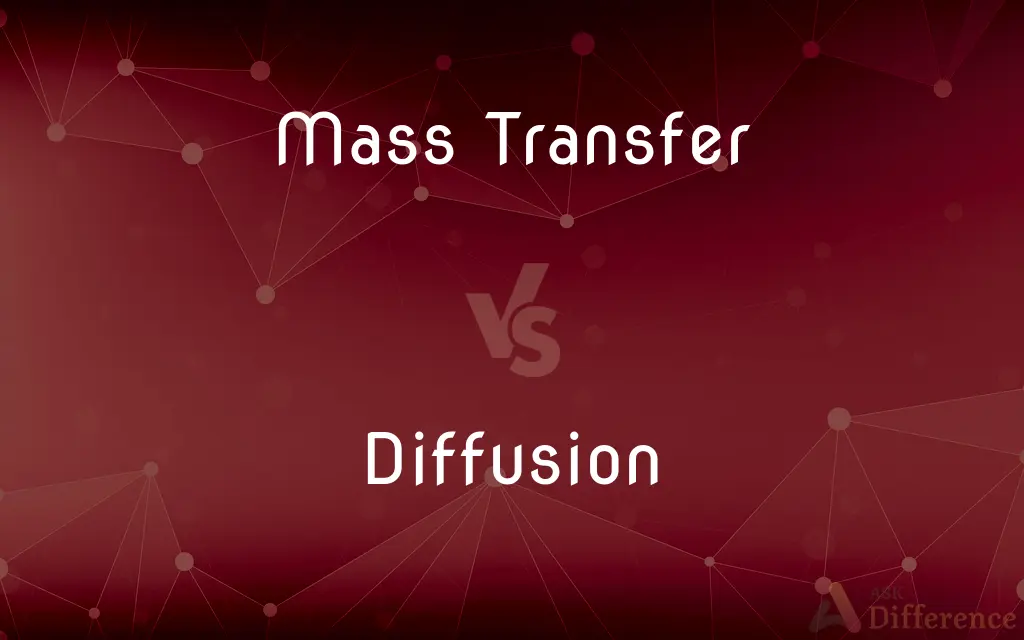Mass Transfer vs. Diffusion — What's the Difference?
By Tayyaba Rehman — Published on November 13, 2023
Mass Transfer encompasses the movement of mass from one point to another, often driven by concentration gradients; Diffusion is the spontaneous movement of particles from a region of higher concentration to lower, without external forces.

Difference Between Mass Transfer and Diffusion
Table of Contents
ADVERTISEMENT
Key Differences
Mass Transfer and Diffusion are integral concepts in the realms of physics and engineering. On the other hand, Diffusion is a specific mechanism under the broader umbrella of mass transfer.
Mass Transfer pertains to the net movement of mass from one location to another, driven by various forces such as pressure and concentration differences. Diffusion describes the spontaneous spread of particles, predominantly because of concentration differences, without the necessity of bulk motion.
Mass Transfer can involve multiple phases and mechanisms like convection and diffusion. So, while all diffusion is a form of mass transfer, not all mass transfer is due to diffusion.
Comparison Chart
Definition
Movement of mass from one point to another.
Spontaneous movement of particles from high to low concentration.
Cause
Pressure, concentration differences, etc.
Concentration gradients alone.
ADVERTISEMENT
Scope
Broader, includes various mechanisms.
Specific mechanism of mass transfer.
Influence of External Forces
Can be influenced by external forces.
Not driven by external forces.
Examples
Movement of solute in a solvent via convection.
Perfume spreading in a room.
Compare with Definitions
Mass Transfer
The net movement of mass from one location to another.
The movement of a dye in water is an example of mass transfer.
Diffusion
Molecular movement driven solely by concentration gradients.
A drop of ink spreads in water through diffusion.
Mass Transfer
The phenomenon affecting the distribution and movement of materials.
Mass transfer principles are essential in designing industrial reactors.
Diffusion
The natural tendency of particles to spread out in a system.
Over time, cream in coffee diffuses, making it uniformly light.
Mass Transfer
It encompasses various mechanisms like convection and diffusion.
In a river, sediments move downstream due to mass transfer.
Diffusion
A specific mechanism under mass transfer without bulk motion.
When perfume is sprayed, it diffuses to fill the room with fragrance.
Mass Transfer
Transfer of substances caused by concentration, thermal, or pressure differences.
In distillation, mass transfer of a component from liquid to vapor phase occurs.
Diffusion
The process of diffusing or the condition of being diffused
The diffusion of new technology around the world.
Mass Transfer
Encompasses both molecular and macroscopic transport of mass.
The separation of components in a mixture involves mass transfer.
Diffusion
The scattering of incident light by reflection from a rough surface.
Diffusion
The transmission of light through a translucent material.
Diffusion
The spontaneous intermingling of the particles of two or more substances as a result of random thermal motion.
Diffusion
The spread of linguistic or cultural practices or innovations within a community or from one community to another.
Diffusion
The act of diffusing or dispersing something, or the property of being diffused or dispersed; dispersion.
Diffusion
(physics) The scattering of light by reflection from a rough surface, or by passage through a translucent medium.
Diffusion
(physics) The intermingling of the molecules of a fluid due to random thermal agitation.
Gaseous diffusion
Diffusion
The spread of cultural or linguistic practices, or social institutions, in one or more communities.
Diffusion
(marketing) The gradual spread and adoption of goods or services.
Diffusion
Exchange of airborne media between regions in space in an apparently random motion of a small scale.
Diffusion
The movement of water vapor from regions of high concentration (high water vapor pressure) toward regions of lower concentration.
Diffusion
The act of diffusing, or the state of being diffused; a spreading; extension; dissemination; circulation; dispersion.
A diffusion of knowledge which has undermined superstition.
Diffusion
The act of passing by osmosis through animal membranes, as in the distribution of poisons, gases, etc., through the body. Unlike absorption, diffusion may go on after death, that is, after the blood ceases to circulate.
Diffusion
(physics) the process of diffusing; the intermingling of molecules in gases and liquids as a result of random thermal agitation
Diffusion
The spread of social institutions (and myths and skills) from one society to another
Diffusion
The property of being diffused or dispersed
Diffusion
The act of dispersing or diffusing something;
The dispersion of the troops
The diffusion of knowledge
Diffusion
Movement of molecules from a region of high concentration to low.
The spread of smoke in a room is due to diffusion.
Diffusion
Occurs without any external influence or force.
The aroma of freshly baked cookies diffuses throughout the house.
Common Curiosities
Does temperature influence mass transfer?
Yes, temperature can affect the rate of both diffusion and other mass transfer mechanisms.
Is mass transfer always in the direction of high to low concentration?
For diffusion, yes, but mass transfer as a whole can be influenced by other factors like pressure or external forces.
Can diffusion occur in solids?
Yes, diffusion can occur in solids, though typically at slower rates than in liquids or gases.
Do both mass transfer and diffusion require a medium?
Both processes typically require a medium, but the specifics depend on the context and materials involved.
Are mass transfer coefficients important in industry?
Yes, they help in designing and understanding various processes, especially in chemical engineering.
Is diffusion always slow?
Relative to some bulk flow mechanisms, diffusion can be slow, especially in liquids and solids, but the rate depends on factors like temperature and medium.
Why is diffusion considered passive?
Because it doesn't require external energy, operating solely on concentration differences.
Can mass transfer include the movement of energy?
While the term primarily refers to material transfer, it's closely related to heat transfer, which is energy movement.
What's Fick's law related to?
Fick's law describes the diffusion process, quantifying the relationship between flux and concentration gradient.
Share Your Discovery

Previous Comparison
Boredom vs. Monotony
Next Comparison
Full Cream Milk vs. Whole MilkAuthor Spotlight
Written by
Tayyaba RehmanTayyaba Rehman is a distinguished writer, currently serving as a primary contributor to askdifference.com. As a researcher in semantics and etymology, Tayyaba's passion for the complexity of languages and their distinctions has found a perfect home on the platform. Tayyaba delves into the intricacies of language, distinguishing between commonly confused words and phrases, thereby providing clarity for readers worldwide.












































